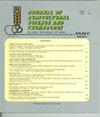粘捕器与基质覆盖对温室壁球侵染迟缓病的物理防治
IF 1.3
4区 农林科学
Q2 AGRICULTURE, MULTIDISCIPLINARY
引用次数: 0
摘要
本研究是为了检验物理防治真菌蚊蚋(brysia agrestis Sasakawa;2014年3月至10月,在全南光阳采用黄色粘捕器和覆盖基质的水培南瓜材料。对照方法是在基质上覆盖一层黑白薄膜,剪去拟种植幼苗的部分。如果在播种后插入定制的黄色粘捕器,使切割部分的基质不暴露,则可以防止成虫的入侵,并且在整个生长期间基质中没有出现幼虫。每10a需8小时覆盖基材并安装黄棍捕集器。另一方面,如果没有被覆盖,则需要88小时才能在生长期进行化学控制。覆盖黑白膜的单株果实数比未覆盖的多7个。根际温度降低约1 (cid:59282),日变化较小。因此,温度是稳定的。如果在土壤和水培作物(如辣椒、黄瓜、草莓)同时进行覆盖,则可以应用该方法。本文章由计算机程序翻译,如有差异,请以英文原文为准。
The Physical Control of Bradysia agrestis by Using Sticky Trap and Substrate Cover in Greenhouse-grown Squash
This study has been made in order to examine the physical control effect against fungus gnat ( Bradysia agrestis Sasakawa; Diptera: Sciaridae) by using a yellow sticky trap and material with which substrate was covered in hydroponic squash in Gwangyang, Jeonnam from March to October 2014. With regard to the control method, the substrate was covered with a black and white film, and a part in which a seedling would be planted was cut out. And if a customized yellow sticky trap was inserted so that the substrate in the cut-out part was not exposed after planting the seedling, the invasion of an adult could be prevented, and no larva appeared in the substrate for the whole growing period. It took 8 hours per 10a to cover the substrate and to install the yellow stick trap. On the other hand, in case of not being covered, it took 88 hours to make an effort at chemical control for the growing period. In case of being covered with black and white film, the number of fruits per plant was larger by 7 in comparison with not being covered. The temperature inside rhizosphere was lower by approximately 1 (cid:59282) , and diurnal variation was small. Thus, the temperature was stable. It was possible to apply this method if mulching was performed at the same time in growing in soil as well as hydroponic crops such as paprika, cucumber, and strawberry.
求助全文
通过发布文献求助,成功后即可免费获取论文全文。
去求助
来源期刊

Journal of Agricultural Science and Technology
AGRICULTURE, MULTIDISCIPLINARY-
CiteScore
1.90
自引率
8.30%
发文量
0
审稿时长
4.5 months
期刊介绍:
Journal of Agricultural Science and Technology is one of the TMU Press journals that is published by the responsibility of its Editor-in-Chief and Editorial Board in the determined scopes.
Journal of Agricultural Science and Technology (JAST) is an international research journal published bimonthly for the purpose of advancing the scientific studies. The subjects covered by JAST include all aspects of agriculture and natural resources (see Areas Covered). The journal will consider submissions from all over the world, on research works not being published or submitted for publication towards publication as full paper, review article and research note. The Papers are published in English with an extra abstract in Persian.
 求助内容:
求助内容: 应助结果提醒方式:
应助结果提醒方式:


